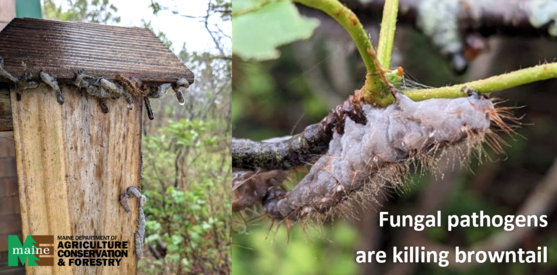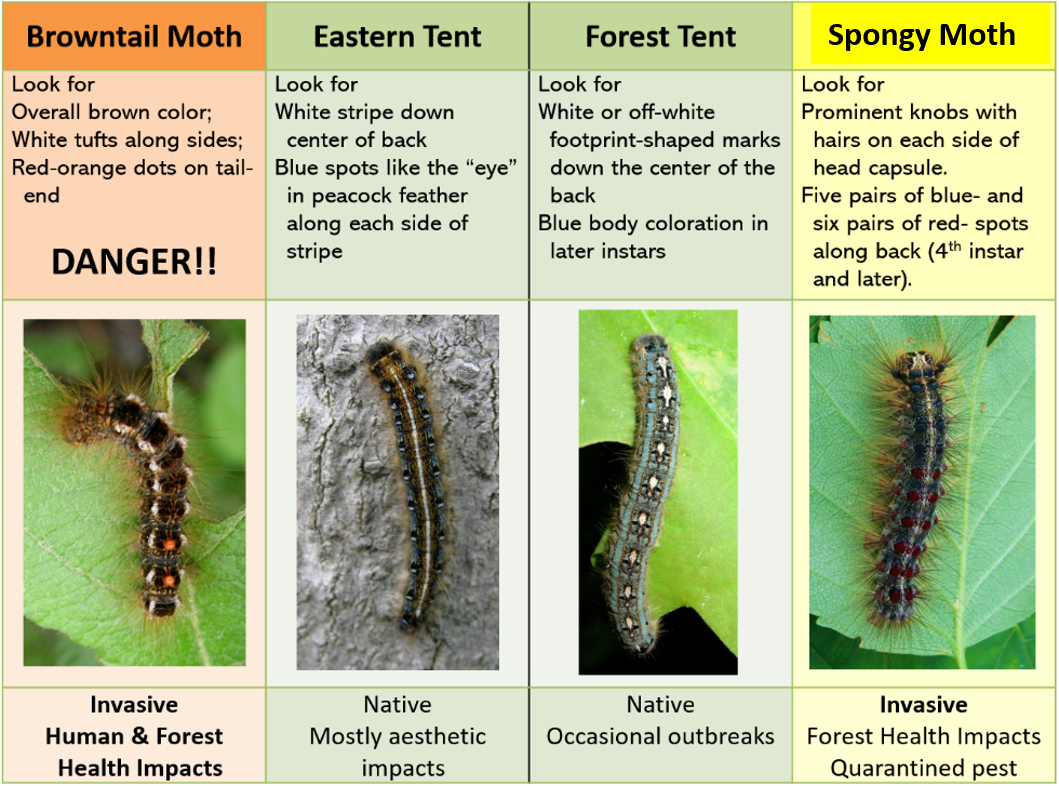Browntail Moth Update #8: June 12, 2023
The first week of June has been very rainy and cold, however, there is a silver lining; this rain has likely helped support the epizootics (disease outbreaks) of fungus and viruses. Responding to a public report, we have confirmed high mortality of browntail caterpillars on Eagle Island, ME off the coast of Harpswell. The likely culprit is a naturally occurring fungus called Entomophaga aulicae and it can be highly contagious to caterpillars in high densities. When a caterpillar encounters the fungus, the fungus enters and multiplies inside of the caterpillar, eventually causing its death. When they die, these caterpillars house large quantities of the fungus and fungal spores, allowing disease to spread to healthy caterpillars. Although this fungus can regulate some populations of browntail caterpillars, in order for an epizootic to happen, rainy weather and the pathogen need to co-occur. Therefore, we should caution that pockets of disease like this may be quite isolated. If you are seeing diseased caterpillars anywhere in the state, we'd love to know! Please send us your reports of diseased caterpillars. We will continue to monitor for disease-causing agents at our developmental monitoring sites and elsewhere in the coming weeks.
 |
Fungal pathogens have caused browntail caterpillars to die. Eagle Island, ME.
The browntail caterpillars that aren't encountering deadly pathogens continue to grow and defoliate their host trees and shrubs. During the rainy weather, many can be found using the undersides of leaves to shield themselves. Their waxy cuticles (outer skin) provide additional protection from the rain.
A browntail caterpillar clings to the underside of this leaf to stay dry. Skowhegan, ME.
Browntail caterpillars continue growing into mid-June and tree defoliation this time of year becomes more obvious. We have been getting many reports of folks seeing defoliated trees and shrubs in their neighborhoods, schools, and public areas. When browntail caterpillars are present in large numbers, complete defoliation is possible. Although defoliation pictured below appears devastating, many defoliated hosts will flush out new leaves later this summer. If you have trees that have heavy infestations of browntail caterpillars, you can help them by protecting their roots.
Host shrubs defoliated in early June from browntail moth caterpillars in Harpswell, ME.
Is it too late to treat my trees infested with browntail caterpillars?
Pesticide applications are most effective for browntail caterpillars when the pesticide product can take effect before late May. Treatments after that time are not recommended and are not part of an effective integrated approach to management (or IPM strategy). Since caterpillars are already wandering to new locations, targeted applications are not possible. Further, pesticide applications at this time of year are more likely to impact other living species in your trees, including pollinators and native insects, without effectively reducing the impacts from browntail. At this time, there are many shed caterpillar skins and toxic hairs that have already built up in the environment. To have more effective control of browntail, plan to target the next generation of caterpillars by scouting out new winter webs this winter to determine which trees you may want to treat next spring.
What else is chewing my trees?
 Eastern tent caterpillars are native to Maine and are abundant throughout the state. To identify these insects, look for a solid white stripe down the center of their back and blue spots that resemble the "eye" in peacock feathers. The good news is this is not a forest pest. It is often considered an aesthetic pest or a concern for plants where fruit production is a goal. This caterpillar feeds on Rosaceae hosts (apples, pears, cherries, serviceberries, hawthorns, and others) and creates a silken tent after hatching from eggs in the spring.
We have received reports and observed defoliation caused by forest tent caterpillars in northern Maine. These caterpillars are native to Maine and can be recognized by the off-white "keyhole" or "footprint" shaped markings on their back. Aspen tends to be the target host in northern Maine; however, these caterpillars can feed on many hardwood species. Most recently, this insect contributed to the death of a mature oak stand in Blue Hill, ME.
Spongy moth caterpillars are an invasive species and have been spotted in many counties of Maine. These hairy caterpillars have prominent knobs on each side of their head, and older caterpillars will have five pairs of blue spots, followed by six pairs of red spots on their back. Like browntail, it has two orange glands toward the rear of the caterpillar, however, spongy moth caterpillars do not have the toxic hairs that browntail have. Because the state experiences different climates, spongy moth caterpillars in some areas are still young and have not yet developed their characteristic blue and red spots yet. These caterpillars develop later in the season and are generally smaller than others (browntail, forest tent, eastern tent) at this time of year. Spongy moth and browntail moth are vulnerable to the similar fungal and viral diseases. We hope the rainy weather will contribute to fungal disease activity especially in spongy moth caterpillars since they are still early in their development.
The not-so-hairy winter moth caterpillars are wrapping up feeding in coastal Maine and have denuded hardwood trees in many areas where they are found. These invasive caterpillars are typically pale green with a faint white stripe running down both sides of its back. Around this time of year, you may find them dangling out of their host trees (oak, maple, ash, apple and other fruit trees) using a silk thread to find additional food or move into the soil below to pupate into moths. Pupae remain in the soil through late fall and can be moved with soil from infested areas. It appears this is a primary way this pest is spread to new areas.
Finally, we have received numerous reports of leaf damage. Frost has hit many tree species quite hard in some portions of the state. This type of damage appears as a wilt symptom to many, but some mistake it for insect feeding.
Sign up for our Conditions Report to stay up to date on other insect and disease topics!
|